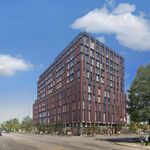A
Antiloop33rpm
Guest
Except that the blocks suitable for development is periperial to the ROW, and not the ROW itself - which can't be sold simply because the space has to be there for the roadway.
True. But the width of the Gardiner/Lakeshore corridor does vary depending on the section of the roadway. There are some parts where new blocks may open up on the side that may or may not be useful to a new road/transit corridor. Also if the tunnel elements underneath are stacked and a surface road of only 6 lanes is constructed they could use some of the excess land to sell to developers and help cover some of the costs of the project. If all these considerations are taken in from the very start then it could far more effective raising funds and ensuring land requirements for the new transportation corridor are met.
I don't disagree with this view - in the perfect world, that's what should happen. However, if I am forced to choose between a scheme that could see the expressway torn down, and one that promises the world but have little chance of going forward, I will take the former first.
Except that you could do nothing and the Gardiner is still going to be torn down sooner rather than later. Just like any other piece of transportation infrastructure, it is going to reach the end of its lifespan and will have to be replaced. Since it is highly unlikely that anyone would consider replacing it with another elevated expressway it would probably result in a 10 lane super street. This outcome requires no effort whatsoever. So really you dont have to choose this option, it more than likely, simply will be.
Depending on the construction methods chosen, the negative impacts can be minimized - and this concern is still predicated upon the assumption that one go ahead with the whole project.
Minimize, but not eliminate. And some aspects, such as commuter traffic are going to be somewhat more difficult to deal with. When this project does start, in whatever form, it will be apparent to anyone travelling or walking in or near that area what is taking place.
I'd argue that politically it is close to impossible to sell the megaproject, and I believe the issue is far too important to put all the eggs in one basket.
Why? Toronto got money for the waterfront and has done well pushing ahead with its plans. It had plenty of support for it's Olympic bids which would have been biilion dollar projects. Expo, probably will turn out to be much the same. Money for arts and cultural institutions. Etc, etc, etc. I am not saying it would be simple to sell. But it is far from impossible. It can be sold to developers as a chance to aquire some new downtown land and add value to exisiting properties in the area. It can be sold to residents of Toronto as a way of opening up the waterfront and creating a beautiful downtown space. It can be sold to suburbanites and 905'ers as a way to provide vastly improved transit downtown and a new highway that even for a small toll they could use. It could be endorsed by te City of Toronto, the TTC, GO, VIA, and any other interested parties.
The main reason I can see that it might seem impossible to sell such a project is because no one has tried yet and no one has emmerged as a politcal leader who is willing to stand behind the idea. Toronto is a city with a lot of creative, intelligent and hard working people and with the proper team of people working on this project I cannot see why there wouldn't be a good chance of it being successful.




